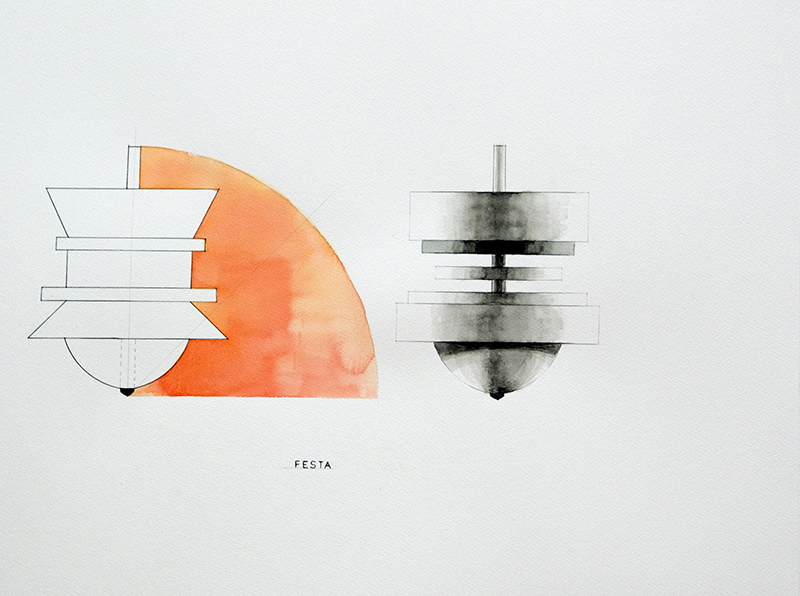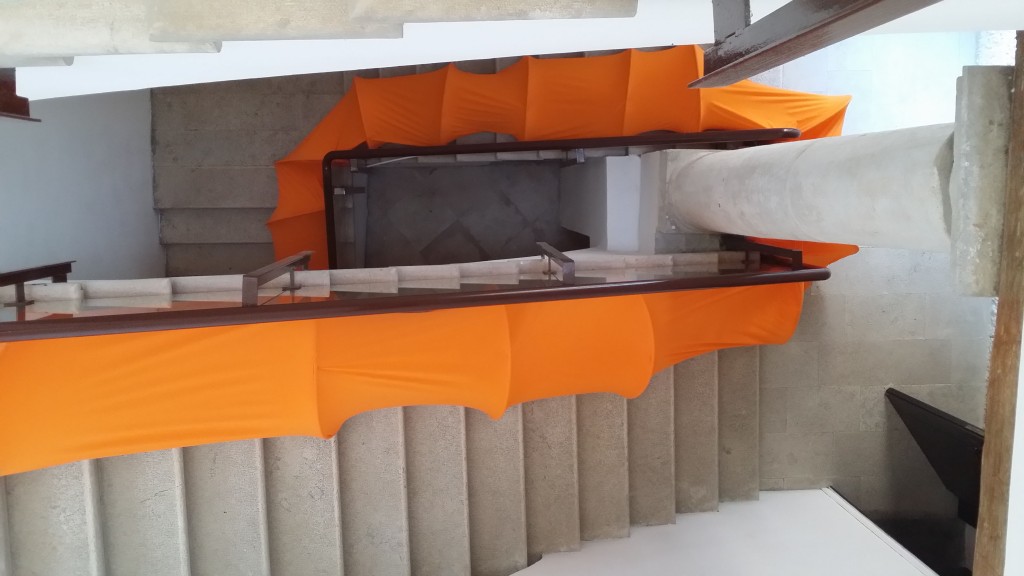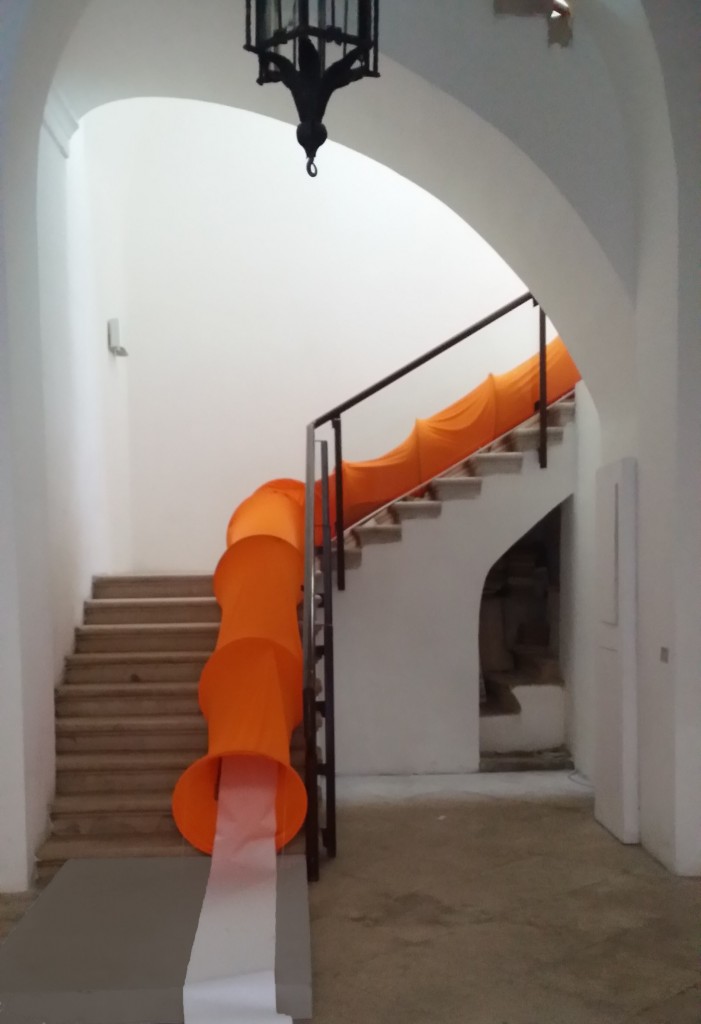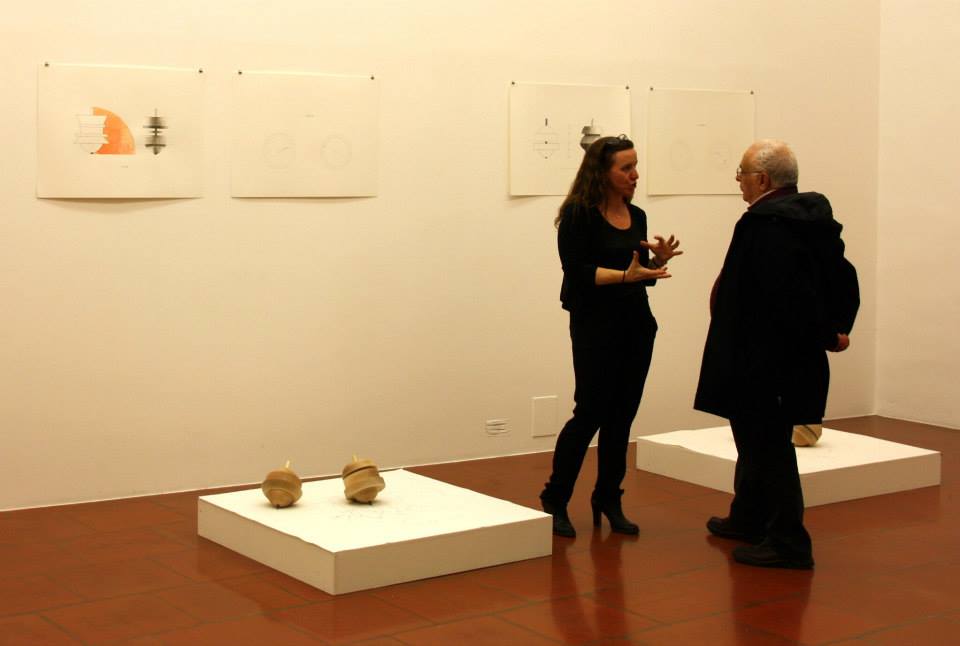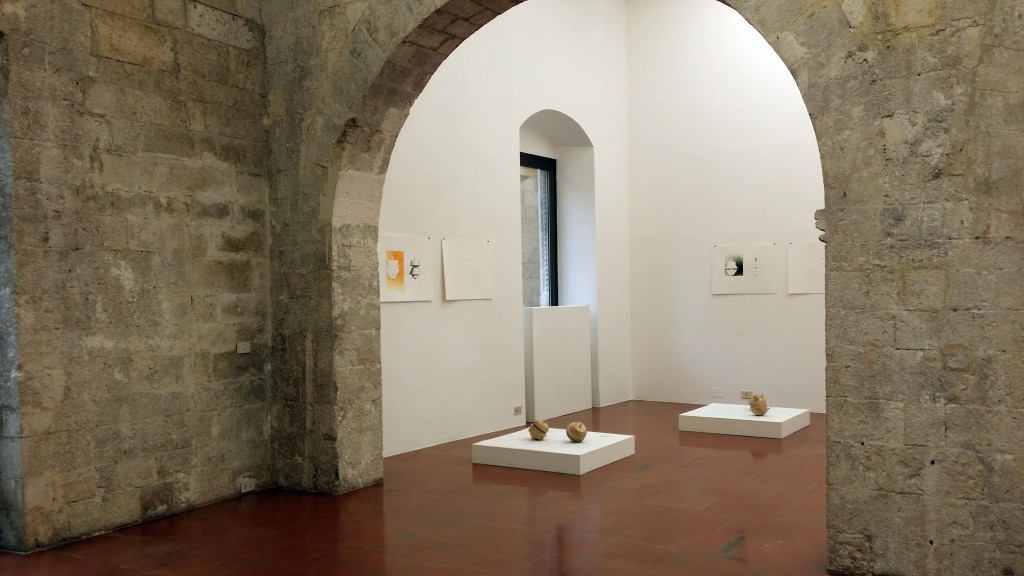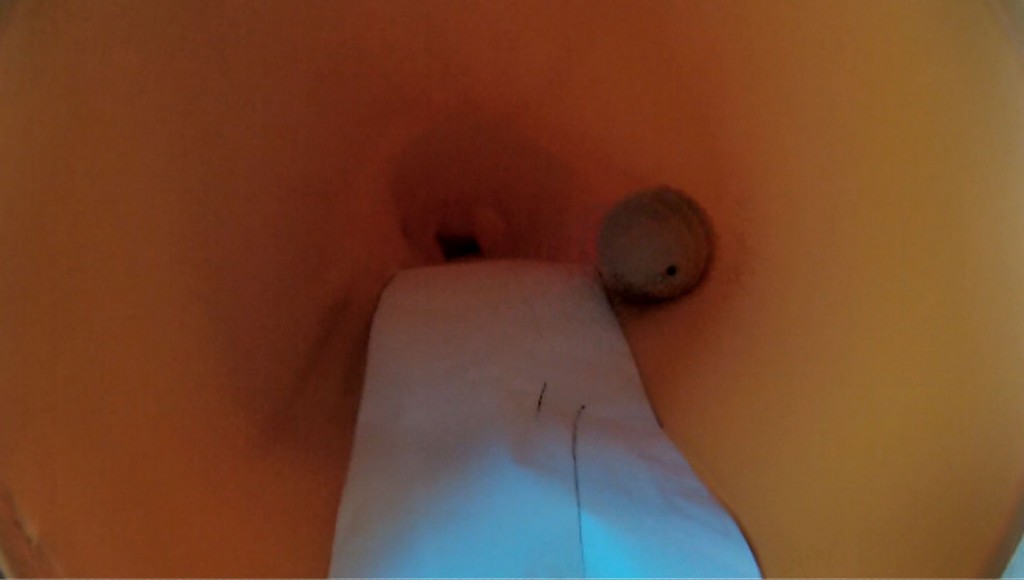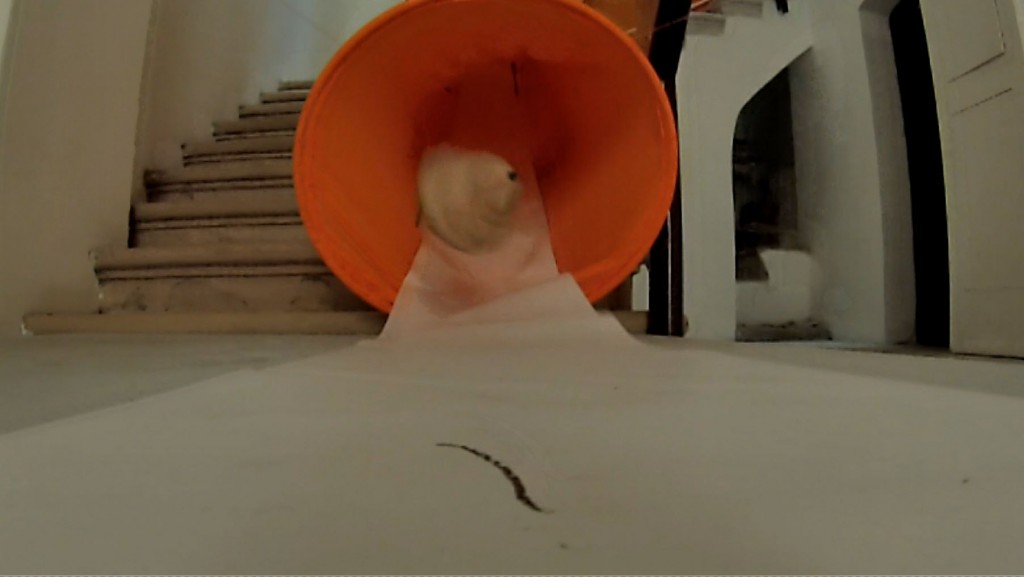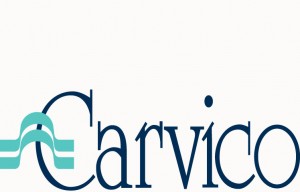DrawingsUrban Interventions
BALANCING, Bari
DOPPELGAENGER 7/27 March 2014Â Â http://www.doppelgaenger.it/?lang=en
Venerdì 7 marzo la galleria Doppelgaenger ospita il progetto speciale Balancing di Elena Cologni, artista italiana con base al Wysing Art Centre di Cambridge, nel Regno Unito. Balancing è la seconda fase di un progetto site specific che prende avvio all’interno di Radio Materiality, iniziativa curata dall’associazione culturale Vessel a Bari nell’estate del 2013. La prima fase del progetto ha visto l’artista impegnata in un dialogo con alcune donne-madri-lavoratrici per approfondire una serie di riflessioni sull’ aspetto sociologico del concetto di fiducia. I dialoghi sono stati tradotti in una raccolta di testimonianze sonore e presentati alla Biennale di Atene del 2013. La seconda fase, posa plastica finale del progetto, è un’installazione performativa. L’artista ha realizzato dieci sculture in legno a forma di trottola con la punta in grafite. La trottola – detta volgarmente Virruzzo – descrive meglio di qualsiasi altro oggetto la tensione del moto verso un equilibrio alterabile, come quello tra una madre e il proprio figlio. Il pubblico potrà partecipare alla performance come in un gioco lasciando che le trottole disegnino, con la grafite, il loro percorso su uno scivolo di tessuto realizzato da Cologni per la scalinata della galleria. Il progetto Balancing è allo stesso tempo manifestazione e ricerca di equilibrio: focalizza l’attenzione su una realtà sociale in costante movimento, realtà dalla quale dipendono instabilità e precarietà dell’equilibrio e dove le madri rimangono l’asse di rotazione per rileggere la storia in funzione del cambiamento.
 Friday 7th of March Doppelgaenger Gallery hosts the special project Balancing by Elena Cologni, Italian Artist based at Wysing Art Centre near Cambridge, in the UK. Balancing is the second phase of a site specific project developed in the context Radio Materiality, curated by cultural association Vessel in Bari in the summer of 2013. For the latter, the artist engaged through dialogues with mums living and working in the city, instrumental for an investigation into the sociological aspect of the notion of trust. The dialogues, translated in a collection of sound documents, have been presented at the Athens Biennale in 2013. The second phase, brings various elements of the project together as a performative installation. The artist has realized ten custom made wooded spin tops with a graphite finished point. The spintop – in the local jargon ‘Virruzzo’ – better than any other object represents a tension towards an alterable balance, never still, just like the one between a mother and her own child. The public will be able to participate in the performance as a game, allowing the spintops to draw their journey down a fabric made slide Cologni will construct on the two flights of the staircase in the Gallery. The project Balancing is manifestation of, and search for, equilibrium at the same time. It points at a social realm in constant evolution, where that very balance becomes unstable and precarious. Within this context mothers act as axes of rotation for taking history forward in new terms
 (first phase of project at https://rockfluid.com/u-struml )
Balancing è la rielaborazione dei dialoghi avvenuti tra Elena Cologni e alcune madri baresi nell’ambito del processo di investigazione artistica e curatoriale Radio Materiality, che vessel sta portando avanti dal 2012. Il cuore dell’indagine è rappresentato dall’area euro-mediterranea e dalle dinamiche di carattere socio e geopolitico esistenti in quest’area, in un dialogo immaginativo che parte dalla Puglia (Bari nello specifico) e che si sviluppa in un orizzonte espanso fatto di affinità , prossimità , conflitti e distanze. Il progetto vede dischiudersi narrative e auto-racconti alternativi, voci altre e dissonanti rispetto a quelle dominanti: voci di donne, di madri, di migranti, di sessualità molteplici che delineano un paesaggio identitario multi-centrico e frammentato. La radio diventa così una metafora della trasmissione di una voce collettiva fatta di individualità e diversità , in un processo di riappropriazione del discorso, della parola e dell’espressione in sé.
24-2-2014 , Sul dialogo
una conversazione tra Elena Cologni e Anna Santomauro
Elena Cologni: Il dialogo è inteso come modo per interagire, scambiarsi punti di vista, essere testimoni dell’elaborazione del pensiero altrui nel presente. Un’immediatezza che porta con sé una tensione creativa importante, e vera.  L’accesso all’informazione così facile com’è in questo momento porterebbe a non cercare di capire attraverso gli altri, ma di affidarsi alla tecnologia. E invece ne abbiamo ancora più bisogno. La forma di conoscenza a cui attingiamo attraverso gli altri non è fatta di nozionismi, ma di esperienza di vita: è fenomenologica. Anna, che ruolo ha il dialogo nel tuo lavoro di curatore?
Anna Santomauro: Penso al dialogo come a una condizione necessaria e imprescindibile dell’agire umano e dunque dell’agire artistico e curatoriale: anche nelle azioni apparentemente spinte da condizioni e aspirazioni individuali l’elemento dialogico è sempre e comunque presente. Esiste un livello di inconsapevolezza nell’atto di dialogare all’interno dei processi di produzione culturale, che è strettamente legato all’elemento collaborativo, sociale e politico del costruire arte e vita a contatto con la realtà e con la sfera pubblica.
E: Nei dialoghi di quest’estate il tuo ruolo fondamentale, anche se di persona silente, è stato quello del testimone, no? Ed è una cosa che per me artista in conversazione con le mamme faceva sì che questi incontri non fossero più solo dialoghi uno a uno. Avvenivano alla presenza di un testimone connotato come tu sei stata in qualità di curatore del progetto, e riproducevano la dinamica del ready made, cioè del fatto di mettere una cosa di uso comune, della quotidianità , sul piedistallo. Allo stesso modo la tua presenza poneva questo momento assolutamente al centro-nocciolo del lavoro, che diventava opera. La tua testimonianza mi consentiva di razionalizzare e contestualizzare, e soprattutto di uscire dal dialogo uno a uno e vedere questa dinamica dall’esterno attraverso i tuoi occhi. Allora alla luce di questo, sentivi di avere questo ruolo?
A: Sicuramente il ruolo di testimone c’è stato: in quei momento mi sono sentita esattamente come colei che guarda ciò che avviene intorno a sé e che in qualche modo ne porta la memoria, no?
E. Sì.
A: Mi sono chiesta spesso quanto la mia presenza, seppur silenziosa e laterale, avesse poi effettivamente un impatto reale sul lavoro, non soltanto sul tuo intervento, ma sull’intero processo relazionale. Sul fatto cioè che tu eri consapevole della mia presenza e sul tuo far affidamento sulla mia testimonianza, sul mio ricordo, certa che questo abbia avuto una certa influenza anche sulle mamme. La mia presenza ha modificato e anche semplicemente a livello inconscio è intervenuta nel flusso della conversazione tra te e le madri per varie ragioni: in alcuni casi per una relazione già esistente tra me e le mamme, in altri per il bisogno diffuso tra tutte noi di approvazione e riconoscimento reciproco. Ho spesso ritrovato questo movimento anche a livello spaziale, nel fatto di dovere collocare le nostre presenze a triangolo, di dover spostare lo sguardo tra tre volti.
E: Allora dopo ti mando una foto che ho fatto di un frammento di un testo di Claire Bishop in cui parla di pratiche collaborative e su cui ho disegnato un diagramma lo scorso autunno. È un triangolo con scritto : io Anna mamma – ruoli. Ecco.
A: A livello relazionale inconscio ho sentito sempre di più, incontro dopo incontro, la consapevolezza in me che la mia presenza stesse incidendo sulla vostra conversazione.
E: Secondo te era poi di nuovo un discorso di fiducia? Nel senso che avendo tu facilitato il contatto con le mamme, non sei stata solo il curatore, ma anche l’agente che ha veicolato la relazione con loro. Quindi forse è stata una questione di fiducia nel senso che tu hai garantito per me e che in virtù di questo loro potevano fidarsi.
A: Sì, secondo me era un gioco di conferme a tre in cui ciascuna di noi avvertiva la pressione di voler confermare se stessa, le proprie motivazioni e l’esistenza stessa di quell’incontro alle altre. Quindi sì, penso che abbia avuto molto a che fare con l’elemento fiducia.
 ***
Balancing is based on a series of dialogues between Elena Cologni and some mothers based in Bari. The project’s research was part of vessel’s curatorial and artistic process of investigation Radio Materiality, started in  2012. At the heart of this is the European Mediterranean area, with the geopolitical and social dynamics. The Apulia region, more specifically Bari, is the starting point for a dialogue expanding on notions of sameness, proximity, conflicts and distances. A project opening up through narratives and alternative self referential stories, other’s voices at times discordant with the dominating discourse: voices of women, mothers, migrants, and from diverse sexual orientation too. All of these define a multi-centric and fragmentary landscape. The radio thus becomes a metaphor for a collective of diverse voices from individuals. This happens within a process of re-appropriation of the discourse and the ‘word’ therein, the very concept of expressing oneself.
24-2-2014 , On dialogue
a conversation betwenn Elena Cologni and Anna Santomauro
Elena Cologni: Dialogue as a way to interact, exchanging of view points, to be witness of others’ thinking process in that very moment, in the present. An immediacy charged with an important, and real, creative tension. Â Today’s easy access to information could suggest to go passed people and go straight to technology to acquire information. Instead we need this even more. The sort of knowledge we have access through others is not constructed on education, but life experience: it’s phenomenological. Anna, what role has the dialogue in your role as curator?
Anna Santomauro: I think at dialogue as a necessary condition, it is unavoidable within human behavior, and thus within artistic curatorial approaches:Â even in the actions apparently based on individualistic conditions and aspirations the dialogic element is always present. There is a level of unawareness within the dialogic act in the processes of cultural production, which is strictly linked to the collaborative, social and political aspects this implies, also in bridging art with life, and reality with the public sphere.
E: In the dialogues last summer you had an instrumental role, albeit silent: that of the witness. And this is something which for me as artist in conversation with the mums allowed these encounters to go beyond the one-to-one. These happened in the presence of a witness, with the specific connotation of curator of the project. I think in terms of this dynamics as reproducing that of the readymade: the notion of placing an object of everyday’s use onto a pedestal. In a similar way your presence would place this moment absolutely at the centre of my work. Your testimony allowed me to rationalize and contextualize, and moreover to step out of the one-to-one dialogue and see this dynamics from outside through your eyes. Did you feel you had such a role?
A: I certainly do, the role of witness was there. In those moments I felt exactly as the one who watches what happens around her and who in some ways bears the memories of this. No?
E. Yes.
A: I often asked myself to what extend my presence, however quite and lateral, would effectively impact on your work, not only on your input, but within the whole relational process. How much your awareness of my presence, and your relying on my testimony and on my memories, also influenced the mothers. My presence modified, and even unconsciously, intervened in the flux of the conversation between yourself and the mothers for a number of reasons: in some cases because of an already existing relationship between myself and them, in others due to a need of approval among all of us, and reciprocal recognition as well. I often thought of this dynamics as a movement in a spatial sense, in the positioning of our presences in a triangular shape, and having to move the gaze among three faces.
E:  And so I shall send you a picture I took of a fragment  from a text by Claire Bishop, where she discusses collaborative practices and where I drew a diagram last autumn. It’s a triangle with some writing:  I Anna mum – roles.
A: At an unconscious level, in terms of the relational aspect, I felt more and more, encounter after encounter, the awareness in myself that my presence was having an impact on your conversations.
E: In your opinion was it then again a matter of trust? I mean that because of your role in facilitating the encounters with the mums, in addition of being that of the curator, and as agent for the relation with them, you were there to guarantee for me, that they could trust me.
A: Yes, I think it was a game of confirmations among the three of us, within which each of us could feel the pressure of one’s own confirmation, and motivation,  as well as the very existence of that encounter with each other. Therefore, yes, I think it had a lot to do with the element of trust.
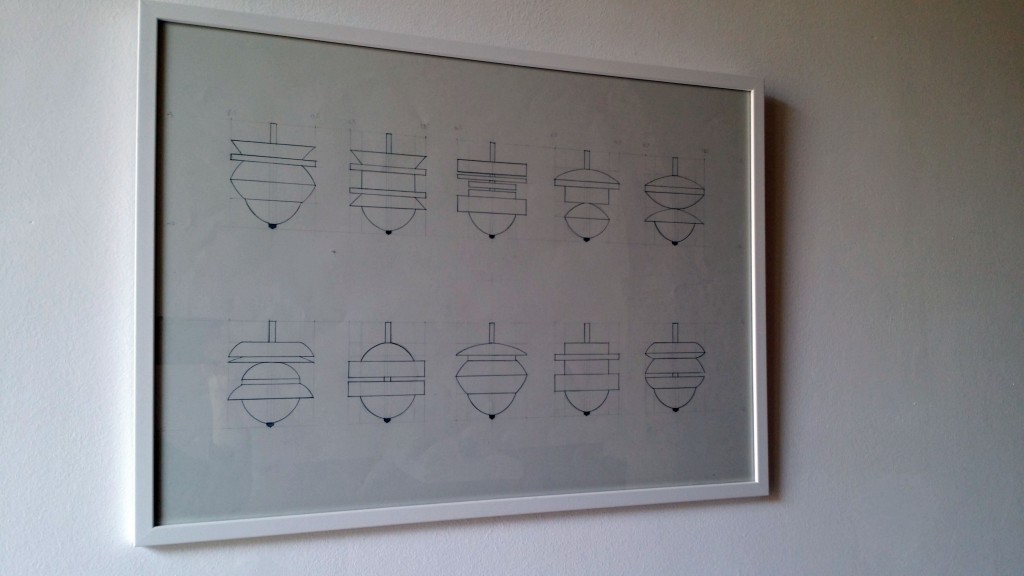
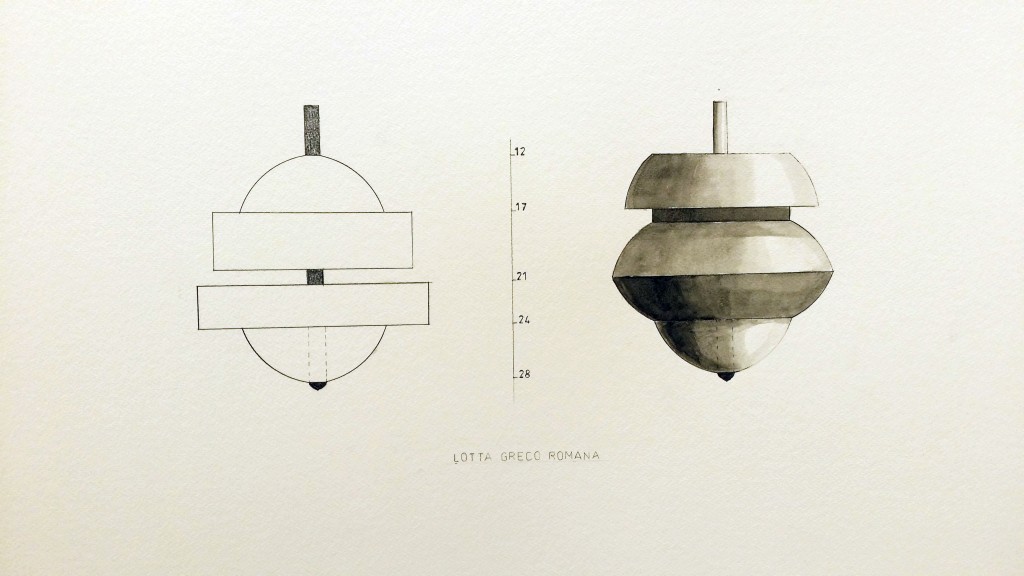
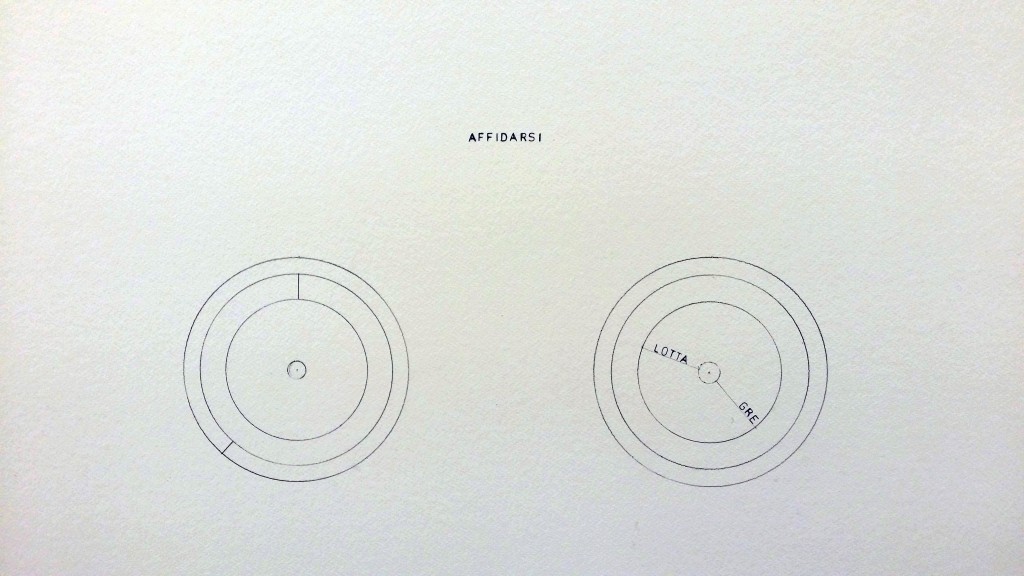
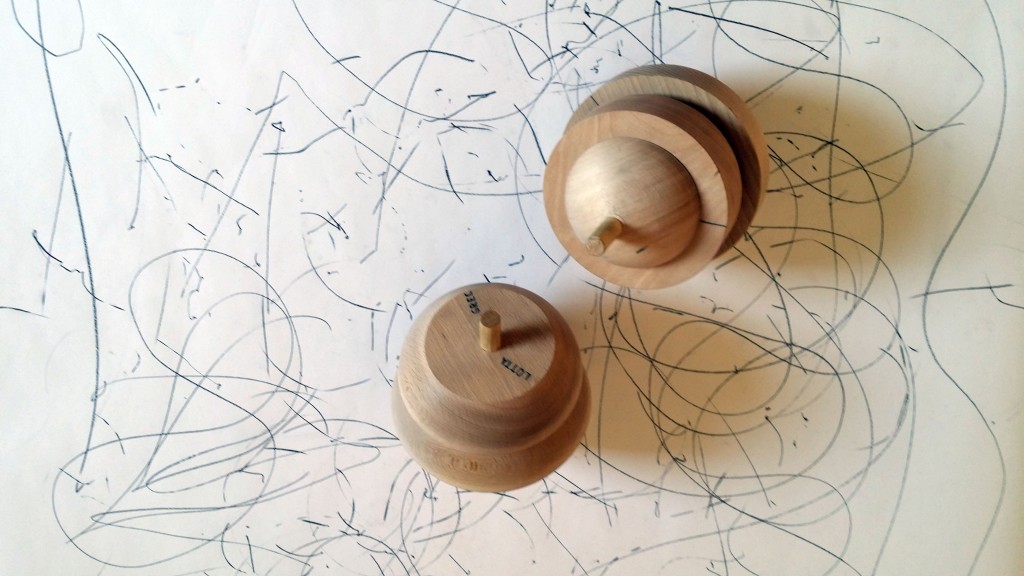 stills from video documentation of performance on the opening night
stills from video documentation of performance on the opening night
Press_Release_Elena_CologniFinale
Elena Cologni è studio artist al Wysing Art Centre (Cambridge), e fa parte del Commonwealth Creativities in Itercultural Arts Network, all’Università di Cambridge. Ha un PhD dal Central Saint Martins College of Art and Design, Londra. E’ stata premiata da: Arts and Humanities Research Council (UK) (2004-2006) Arts Council of England (2009) e Escalator Live Art e Visual Art Arts Council of England (2011). E’ stata selezionata per residenze al Centre for Contemporary Arts Glasgow (2006), allo Yorkshire Sculpture Park (2009) e alla facoltà di Psicologia Sperimentale, University  of Cambridge (Rockfluid 2011). I suoi lavori artistici sono raggruppati per tematiche in progetti, all’interno dei quali Cologni apre a collaborazioni, spesso interdisciplinari come in quest’ultimo, incentrato su memoria, percezione e luogo.   |  is studio artist at Wysing Art Centre (Cambridge), and is a member of the Commonwealth Creativities in Itercultural Arts Network, University of Cambridge. She has a PhD from Central Saint Martins College of Art and Design, London. She was awarded from Arts and Humanities Research Council (UK) (2004-2006) Arts Council of England (2009) and Escalator Live Art and Visual Art Arts Council of England (2011). She was selected for residencies at Centre for Contemporary Arts Glasgow (2006), Yorkshire Sculpture Park (2009) and at Department of Experimental Psychology, University of Cambridge (Rockfluid 2011). Her works are developed through projects, and for these Cologni collaborate with other, often with an interdisciplinary approach, as in the most recent, on memory, perception and place.
Anna Santomauro (1983) è critica e curatrice. Nel 2011 ha fondato insieme a Viviana Checchia l’organizzazione non profit Vessel a Bari, organizzazione non-profit. E’ interessata alle pratiche artistiche e  curatoriali cosiddette sociali e all’arte come strumento per la produzione di immaginari socio-politici alternativi. Ha sviluppato diversi progetti e curato diverse mostre tra cui: The Pacifist Library – Sarajevo, progetto di Valentina Curandi e Nathaniel Katz (2013); programma radiofondico Work in the Field, nell’ambito del progetto AeliaMedia di Pablo Helguera (2012); For an Ecology of the Museum presso il Museo di Villa Croce di Genova (2012). Nel 2013 ha tenuto il seminario Curating Collaborative Strategies in Peripheral Areas presso la Newcastle University. Scrive per la rivista Arte e Critica. Si è laureata e ha un master dall’università di Bologna ( 2012). |  is an independent curator and critic. She is the Co-Founder and Chief Curator of Vessel in Bari, Italy, a non-profit arts organization devoted to developing critical discourse around pertinent contemporary social, political, and economic issues. She has developed several projects and curated multiple exhibitions such as The Pacifist Library – Sarajevo, a project by Valentina Curandi and Nathaniel Katz (2013); Work in the Field, a community-based radio program within Pablo Helguera’s project AeliaMedia (2012); and For an Ecology of the Museum at the Museum of Villa Croce in Genoa, Italy (2012). In early 2013 she taught a research seminar at Newcastle University on independent curation. Santomauro received her Master’s in Visual Arts at Bologna University, graduating with honors in 2012.
photographs courtesy of Luciana Galli and Vito Palmisani
Elena Cologni is supported by Arts Council of England. The exhibition has been sponsored by Carvico SPA (www.carvico.com)
